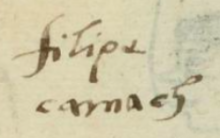Camach (MH629v)
This black-line drawing of the compound glyph for the personal name Camach (perhaps "Jaw") is attested here as a man's name. The compound glyph consists of two elements, a jaw (camachalli) and a hand (maitl). The jaw is part of a mouth shown in profile, facing toward the viewer's right. The mouth is open somewhat. The upper lip curls up and back, more like an animal's mouth than a human mouth. The hand is attached to an arm that comes out from the mouth. The hand--a right hand--appears in a frontal view with the fingertips pointing upward. The hand plays a phonetic role, providing the "ma" syllable.
Stephanie Wood
For a similar (and even more) curling lip, see Tlatonac, below. Notice how teeth are not shown here, so the reader would not conclude that the reading is tlantli. To read the description of the jaw (camachalli) in the Florentine Codex, see the Digital Florentine Codex, Book 10, Folio 76r: https://florentinecodex.getty.edu/book/10/folio/76r
Stephanie Wood
filipe
camach
Felipe Camach
Stephanie Wood
1560
Jeff Haskett-Wood
mouths, bocas, jaws, jawbones, quijadas, hands, manos, fonetismo, nombres de hombres

camachalli, jawbone, https://nahuatl.wired-humanities.org/content/camachalli
camac, in the mouth, https://nahuatl.wired-humanities.org/content/camac-0
Quijada-Mejilla-Boca
Stephanie Wood
Matrícula de Huexotzinco, folio 629v, World Digital Library, https://www.loc.gov/resource/gdcwdl.wdl_15282/?sp=341st=image.
This manuscript is hosted by the Library of Congress and the World Digital Library; used here with the Creative Commons, “Attribution-NonCommercial-ShareAlike 3.0 License” (CC-BY-NC-SAq 3.0).





